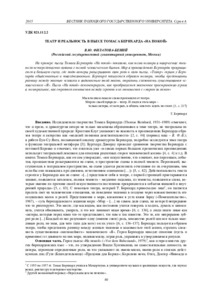Please use this identifier to cite or link to this item:
https://elib.psu.by/handle/123456789/14057Full metadata record
| DC Field | Value | Language |
|---|---|---|
| dc.contributor.author | Филатова-Бений, В. Ю. | - |
| dc.date.accessioned | 2015-10-08T12:44:57Z | - |
| dc.date.available | 2015-10-08T12:44:57Z | - |
| dc.date.issued | 2015 | - |
| dc.identifier.citation | Вестник Полоцкого государственного университета. Серия A, Гуманитарные науки. - 2015. - № 10. – C. 40-43. | ru_RU |
| dc.identifier.issn | 2070-1608 | - |
| dc.identifier.uri | https://elib.psu.by/handle/123456789/14057 | - |
| dc.description | Theatre and Reality in the Play «Eve of Retirement» By Thomas Bernhard. V. Filatova-Beniy (Russian State University For the Humanities, Moscow) | ru_RU |
| dc.description.abstract | На примере пьесы Томаса Бернхарда «На покой» показано, как тема театра в творчестве писателя непосредственно связана с темой человеческого бытия. Мир в произведениях Бернхарда превращается в большую сцену, где люди-актеры разыгрывают свои роли и свои пьесы. «Театр» скрыт у Бернхарда обыденностью и повседневностью. Бернхард пользуется образом театра, чтобы представить разницу между жизнью человека и видимостью этой жизни, отразить сложность существования человеческого «Я». Пьеса «На покой» демонстрирует, как преобразуется жизненное пространство героев в театральное, как строятся отношения между героями и их отношения с «миром за окном».= The goal of this article is to show in the play «Eve of Retirement» by Thomas Bernhard an example of how the topic 'theatre in the writer’s works' is closely connected with human reality. In the works of Bernhard the world turns into a big stage where people – actors play their own roles and parts. Bernhard’s «theatre» is concealed with commonness and everyday routine. Bernhard uses the theatre form in order to portray the difference between the life of a person and the appearance of his life, to present the complexity of the human «I». «Eve of Retirement» demonstrates how the living space of figures converts into Bernhard-theatrical space, how the build up of the relationships between figures relates with the «world out of window». | ru_RU |
| dc.language.iso | ru | ru_RU |
| dc.publisher | Полоцкий государственный университет | ru_RU |
| dc.relation.ispartof | Веснік Полацкага дзяржаўнага ўніверсітэта. Серыя А, Гуманітарныя навук | be_BE |
| dc.relation.ispartof | Herald of Polotsk State University Series A, Humanity sciences | en_EN |
| dc.relation.ispartof | Вестник Полоцкого государственного университета. Серия A, Гуманитарные науки | ru_RU |
| dc.relation.ispartofseries | Серия A, Гуманитарные науки;2015. - № 10 | - |
| dc.rights | open access | ru_RU |
| dc.subject | Государственный рубрикатор НТИ - ВИНИТИ::ОБЩЕСТВЕННЫЕ НАУКИ::Литература. Литературоведение. Устное народное творчество | ru_RU |
| dc.subject | Австрийская литература | ru_RU |
| dc.subject | драматургия | ru_RU |
| dc.subject | Томас Бернхард (Thomas Bernhard, 1931–1989) | ru_RU |
| dc.subject | пьеса Т.Бернхарда «На покой» | ru_RU |
| dc.subject | тема театра | ru_RU |
| dc.title | Театр и реальность в пьесе Томаса Бернхарда «На покой» | ru_RU |
| dc.type | Article | ru_RU |
| dc.identifier.udc | 821.112.2 | - |
| Appears in Collections: | 2015, № 10 | |
Items in DSpace are protected by copyright, with all rights reserved, unless otherwise indicated.
